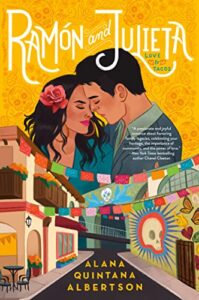Ramón and Julieta is my 30th book, but one of the biggest struggles in my earlier novels was how to use setting. I was an English Literature major at Stanford, and I remember that back then when I was reading assigned books, I was certain that I could never ever create beautiful worlds like the ones that lived in the books that I devoured. I remember being engrossed in Kiana Davenport’s Shark Dialogues and truly feeling like I was in Hawai’i. Her writing style seemed effortless, and I could smell the plumeria and taste the poi and see the sunsets. But reading wonderful novels didn’t help my writing at the time—instead, it reassured my belief that I could never write a novel.
When I finally began my fiction writing journey, my characters often were talking heads, devoid and detached from their surroundings. After years of studying craft, I eventually learned how to use setting to not only enhance my books but to utilize surroundings as characters. In my latest novel, Ramón and Julieta both live in San Diego, California, but in two very different  parts. Ramón lives in a very wealthy, mostly white (82.5%) neighborhood of La Jolla, and Julieta lives in Barrio Logan, a historically ethnic Mexican-American barrio. The setting of my book is as important as the story. Let me repeat that—without the neighborhoods and descriptions of the locations, my book would not have the same impact and flavor.
parts. Ramón lives in a very wealthy, mostly white (82.5%) neighborhood of La Jolla, and Julieta lives in Barrio Logan, a historically ethnic Mexican-American barrio. The setting of my book is as important as the story. Let me repeat that—without the neighborhoods and descriptions of the locations, my book would not have the same impact and flavor.
So enough about me . . . how can you learn to use setting in your own books. Here are five tips:
-
Immerse yourself.
We are not all able to visit or live in the locations where our books are set. But if you are able to go to where your book is set, take a journal and people watch. What are people wearing? How do they speak—slowly and laid back like in beachy SoCal or faster with more urgency like some big city on the East Coast? What is the weather like? (It’s winter in San Diego and I’m writing this outside wearing sandals and drinking an iced coffee.) What types of food or drinks are popular? Take notes and really breathe in the area. If you are not able to visit, watch videos or documentaries or TikToks from locals to get a sense of your space.
-
Use all five senses.
Make sure to describe what you feel, see, smell, hear, and taste. Good descriptions incorporate all these elements, but not necessarily in the same paragraph. Give your readers a true window into this world.
-
Make a list or series bible.
If you are writing fantasy/paranormal/sci-fi/suspense or any genre that requires you to create a world, make sure you understand all the elements that create where your characters reside. To be clear, not all of this research will go into your book but knowing it when you write will make your world seem more real.
-
Pick your setting carefully.
There is a reason small-town romance is a beloved genre and winter hallmark movies are set in the snow. Readers have expectations for settings. In small-town romances and cozy mysteries, there are shop owners and pumpkin farms, and coffee shops that add to the character of the novel. Or in suspense novels, the characters may be in an abandoned barn or castle or under a bridge. It is important to know while you are writing that choosing a specific setting will invoke feelings in your readers.
-
Have your characters live in their world.
Your characters must genuinely interact with their surroundings. It should be purposeful and organic. Throughout my book, Ramón feels like a fish out of water in Barrio Logan. His journey to embracing the town and more importantly having the town embrace him is very important to the conflict and plot of the novel.
Setting can be very fun to write. Often, my first drafts have little setting and I go back into the manuscript during edits and really go deep into the world. Or an editor or beta reader can help make you aware of areas you need to ground your characters in their surroundings.
Next time you pick up a new novel, notice how the author uses setting to tell the stories. I can’t wait to immerse myself in your worlds!


